Few folks realize it, but there’s a great place to invest our money to profit from “DC drama” like the debt-ceiling fiasco. It’s literally hiding in plain sight.
I’m talking, oddly enough, about government debt! But not federal-government debt. Instead we’re going to bypass DC and go with municipal bonds, which are issued by sleepier (in a good way!) state and local governments to pay for infrastructure projects.
Because here’s what most folks don’t realize: “munis” do great when political shenanigans abound in DC. To see what I mean, think back to 2011, another period when a Republican House and a Democratic president scrapped over the debt ceiling.
Munis? They soared 9% that year—a big gain for this normally subdued asset class—going by the performance of the benchmark iShares National Muni Bond ETF (MUB):
Munis Soared Through the 2011 Debt-Ceiling Fiasco
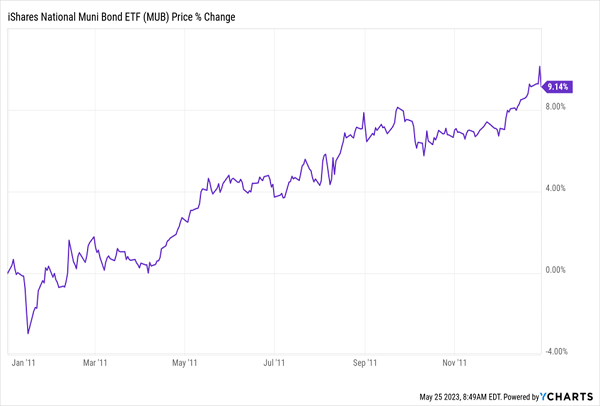 And that gain didn’t include their distributions. MUB, for its part, yields 2.2%, which is more than the typical S&P 500 stock, sure. But if we buy our munis through a closed-end fund (CEF) instead, we can get yields that triple that 2.2%: the three muni-bond CEFs we’ll discuss in a bit yield 6.8% on average.
And that gain didn’t include their distributions. MUB, for its part, yields 2.2%, which is more than the typical S&P 500 stock, sure. But if we buy our munis through a closed-end fund (CEF) instead, we can get yields that triple that 2.2%: the three muni-bond CEFs we’ll discuss in a bit yield 6.8% on average.
Here’s the best part about munis: their interest payments are tax-free for most Americans, so their “real” payouts will be higher for you—potentially much higher, depending on your tax bracket.
Nuveen, sponsor of two of the CEFs we’ll zero in on in a second, provides a calculator that calculates this for us. As you can see, a taxpayer in the highest bracket would pull a 9.4% taxable-equivalent yield from the 5.5%-paying Nuveen Municipal Credit Opportunities Fund (NMCO)!
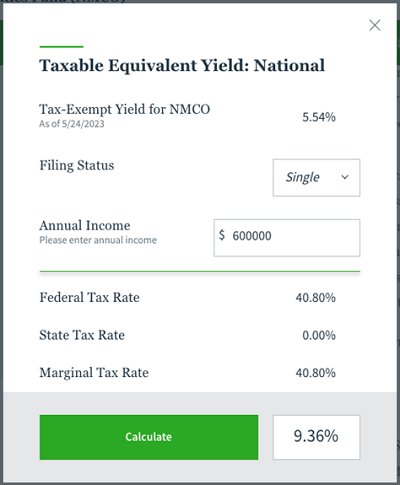 Source: Nuveen
Source: Nuveen
With that in mind, let’s talk about those three high-yielding muni-bond funds, which give us three ways to profit:
- Portfolio gains, particularly if this year ends up looking like 2011—and it does so far!
- Narrowing discounts, as their discounts to net asset value (NAV, or the value of the bonds they hold) return to normal levels, pushing their prices up as they do. (This is a unique feature of CEFs. ETFs, for their part, never trade at discounts.)
- Their high tax-free dividends, of course!
With that in mind, our three “DC-proof” municipal-bond CEFs are the aforementioned NMCO, plus the RiverNorth Flexible Municipal Income Fund II (RFMZ) and Nuveen Dynamic Municipal Opportunities Fund (NDMO). These are currently the highest-yielding and most heavily discounted muni-bond CEFs out there, as you can see below:
 Together, these funds boast yields averaging 6.8%, and they’re broadly diversified, with nearly 900 bonds from hundreds of issuers across the country. Holdings include bonds from the Southern Ohio Port Authority (NDMO), the State of Illinois (NMCO) and Chicago O’Hare International Airport for RFMZ, which also holds a couple of muni-bond CEFs among its top-five holdings.
Together, these funds boast yields averaging 6.8%, and they’re broadly diversified, with nearly 900 bonds from hundreds of issuers across the country. Holdings include bonds from the Southern Ohio Port Authority (NDMO), the State of Illinois (NMCO) and Chicago O’Hare International Airport for RFMZ, which also holds a couple of muni-bond CEFs among its top-five holdings.
Bear in mind, too, that default rates for municipal bonds historically are less than 0.03%, meaning fewer than one of your bonds across these funds is likely to default, which would have an imperceptible effect on our 3-fund portfolio’s performance.
But the most intriguing play here is the discount. As you can see above, all three of these funds trade well below their average discounts. As they move back toward more “normal” levels, their prices will rise, as mentioned above.
I think we can do even better, though, as the end of Federal Reserve interest-rate hikes should boost munis’ prices. But the CEF market is typically slow to respond to changes like this, which is why these discounts are still available to us.
To see the kind of profits a move back to premium territory could deliver, consider NDMO, which went from an 8% discount to par during the month of January, driving a 14% price gain—a huge return for a muni-bond fund:
NDMO’s Disappearing Discount Drove a 14% Gain in 1 Month
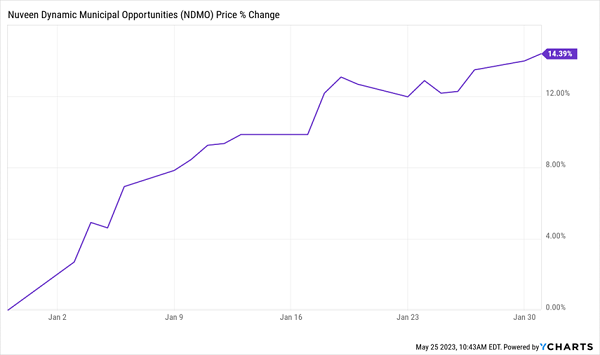 With NDMO back at a 6% discount, we have a nice opportunity to ride along again as it cycles back to a premium. Meantime, the slow-moving (and irrational) CEF market has kept the discounts on RFMZ and NMCO in place all year:
With NDMO back at a 6% discount, we have a nice opportunity to ride along again as it cycles back to a premium. Meantime, the slow-moving (and irrational) CEF market has kept the discounts on RFMZ and NMCO in place all year:
RFMZ and NMCO Are Still on Sale (for Now)
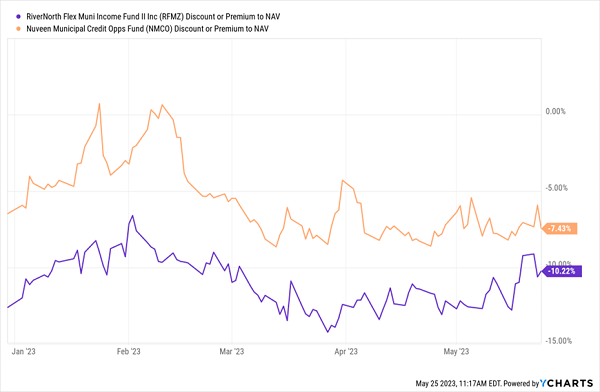 That makes no sense, especially in light of the fact that NMCO and NDMO are very similar funds.
That makes no sense, especially in light of the fact that NMCO and NDMO are very similar funds.
We actually recommended NDMO in a November 2022 Contrarian Outlook article, alongside the Nuveen Select Tax Free Income Portfolio (NXP), which is up about 5% year to date, about the same as NDMO, which is, again, a strong return for a muni-bond fund.
NXP Was Another Winner
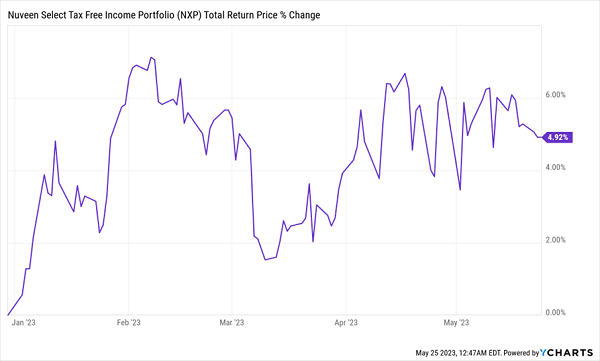 The bottom line is that I now see similar profits to NDMO’s short-term pop, and similar long-term gains as NXP’s measured market outperformance, with NDMO, NMCO and RFMZ—and that’s before accounting for their 5.8% tax-free average dividend yield.
The bottom line is that I now see similar profits to NDMO’s short-term pop, and similar long-term gains as NXP’s measured market outperformance, with NDMO, NMCO and RFMZ—and that’s before accounting for their 5.8% tax-free average dividend yield.
That makes now a great time to buy all three: NDMO to ride along as its discount flips back to a premium; NMCO to front-run the same wave that will likely drive NDMO; and RFMZ for similar reasons, plus its 7.5% tax-free dividend, the highest of our trio.
— Michael Foster
Get My Top 5 Monthly Paying CEFs Now—While They’re Still Cheap [sponsor]
Here’s something else you’ll love about these three funds: they all pay dividends monthly. And here at Contrarian Outlook, we know income investors love their monthly dividends—they write in to tell us as much on the regular!
It’s just so much simpler to get paid every month if you’re leaning on your portfolio to pay your bills. And if you’re reinvesting your payouts, you can do so much quicker with monthlies than quarterlies.
With all that in mind, I’ve crafted a 5-fund portfolio containing my very best picks among monthly paying CEFs. This unique collection of bargain-priced funds yields a sturdy 9.4% now and is highly diversified, so you can consider them a nice “add on” to the three municipal-bond CEFs we just talked about.
Click here and I’ll tell you all about these 5 retirement-changing monthly payers and show you how to download a free Special Report that spills the beans on all 5 of them (revealing their tickers, names, current yields and more).
Source: Contrarian Outlook
